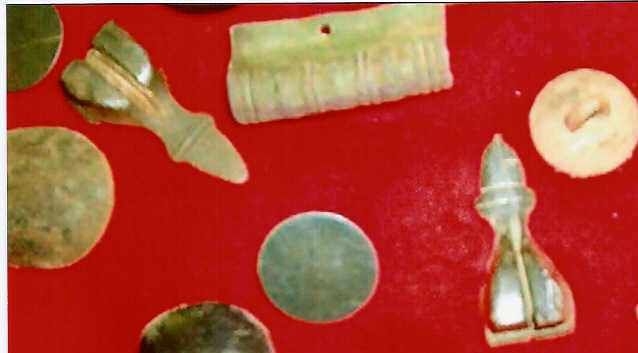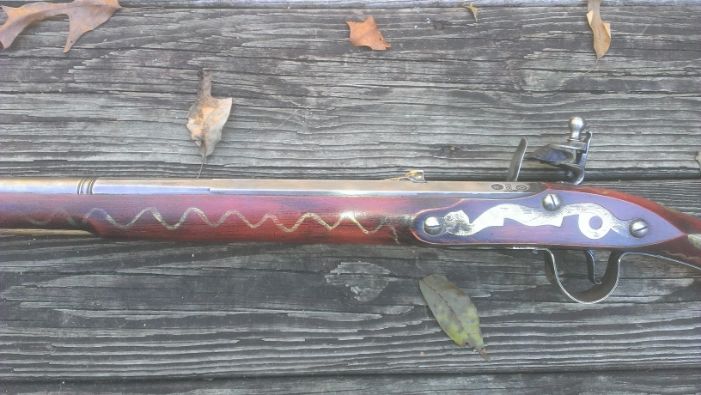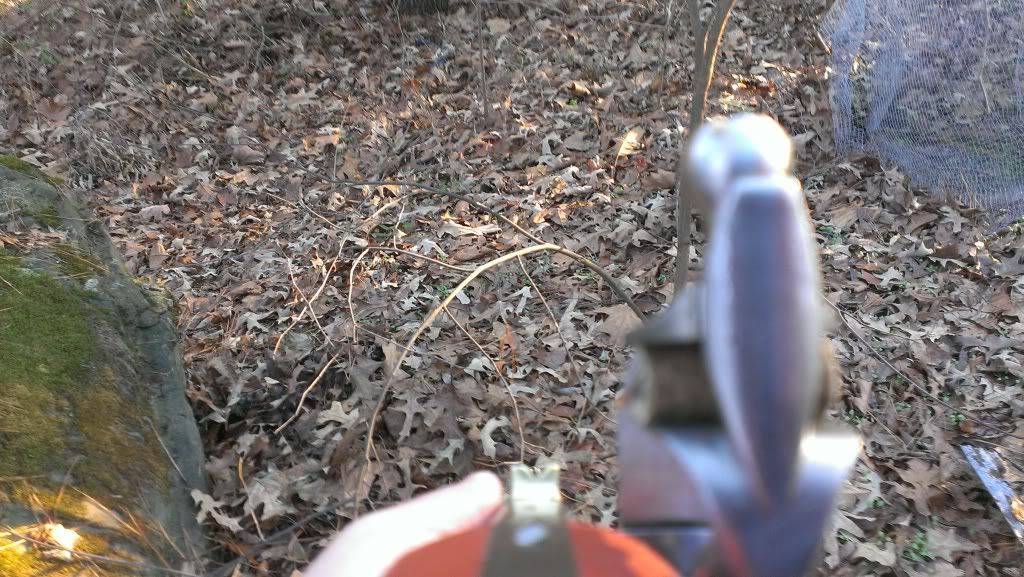Grandpa Ron
45 Cal.
- Joined
- Jan 17, 2011
- Messages
- 571
- Reaction score
- 10
Rather than steal another post I would like to resolve the issue of rear sights on smoothbore trade guns and fowlers.
In that previous post someone questioned my assertion that a number of such guns have been found with rears sights. I particularly admired those brass sights attributed to the Wilson family; a long time supplier of smoothbores to the British.
The first photo below shows two of the sights I was referring to; These were found in 2002 by the State of Florida. They were excavated a site located in the Apalachicola River. I believe they date to 1763. The archeological dig found several of what we now call the Type G barrels and flintlock mechanisms along with some other gun barrels. These barrels had brass back sights and could be identified as R*W (Richard Wilson) manufacture.

The used of this same type sight is also mentioned on page 72 of T. M. Hamilton’s book, Colonial Frontier Guns. Two more of these sights are shown below dating from the 1720’s to perhaps the 1770’s. Again these are Type G trade guns.

How old is the use of sights on smoothbores? That would be anybody’s guess. Referring again to Hamilton’s book; on page 25 he show a gun barrel presumed to be of Dutch manufacture from 1650 or earlier with the remnants of a rear sight.
But what of the French and what we now call the Type C and Type D trade guns? Referring to Kevin Gladysz’s book, The French Trade Gun in North America, rear sight are shown as features in the more elaborate and expensive models. Kevin book pays particular notice to the guns manufactured at the Saint Etienne Factory.
As for the lowly trade gun, we must refer back to page 33 of Hamilton’s book to find a Type C with a rear sight.
Another example of a rear sight is pictured close up, with dimensions, on page 74 of Ryan Gale’s book, For Trade and Treaty. It is on a Wheeler Northwest Gun from the 1814 ”“ 1820 period.
Finally, what of the classic fowling piece; those long barreled, big bore, shoulder arms of Colonial America? For this we must turn to Tom Grinslades’s book, Flintlock Fowlers. This book discusses fowling pieces from 1700 ”“ 1820 mostly of East Coast manufacture. Grinslade provides no description of the few sights that appear in the many pictures of fowlers presented. It does however show that, though rare, rear sights were present on fowling pieces.
From the above I believe it is safe to say that a rear sight, though rare, is indeed well documented.
Because it was not very common, those who compete with smoothbores chose to use the more traditional “no rear sight above the plain of the barrel” rule.
In that previous post someone questioned my assertion that a number of such guns have been found with rears sights. I particularly admired those brass sights attributed to the Wilson family; a long time supplier of smoothbores to the British.
The first photo below shows two of the sights I was referring to; These were found in 2002 by the State of Florida. They were excavated a site located in the Apalachicola River. I believe they date to 1763. The archeological dig found several of what we now call the Type G barrels and flintlock mechanisms along with some other gun barrels. These barrels had brass back sights and could be identified as R*W (Richard Wilson) manufacture.

The used of this same type sight is also mentioned on page 72 of T. M. Hamilton’s book, Colonial Frontier Guns. Two more of these sights are shown below dating from the 1720’s to perhaps the 1770’s. Again these are Type G trade guns.

How old is the use of sights on smoothbores? That would be anybody’s guess. Referring again to Hamilton’s book; on page 25 he show a gun barrel presumed to be of Dutch manufacture from 1650 or earlier with the remnants of a rear sight.
But what of the French and what we now call the Type C and Type D trade guns? Referring to Kevin Gladysz’s book, The French Trade Gun in North America, rear sight are shown as features in the more elaborate and expensive models. Kevin book pays particular notice to the guns manufactured at the Saint Etienne Factory.
As for the lowly trade gun, we must refer back to page 33 of Hamilton’s book to find a Type C with a rear sight.
Another example of a rear sight is pictured close up, with dimensions, on page 74 of Ryan Gale’s book, For Trade and Treaty. It is on a Wheeler Northwest Gun from the 1814 ”“ 1820 period.
Finally, what of the classic fowling piece; those long barreled, big bore, shoulder arms of Colonial America? For this we must turn to Tom Grinslades’s book, Flintlock Fowlers. This book discusses fowling pieces from 1700 ”“ 1820 mostly of East Coast manufacture. Grinslade provides no description of the few sights that appear in the many pictures of fowlers presented. It does however show that, though rare, rear sights were present on fowling pieces.
From the above I believe it is safe to say that a rear sight, though rare, is indeed well documented.
Because it was not very common, those who compete with smoothbores chose to use the more traditional “no rear sight above the plain of the barrel” rule.









